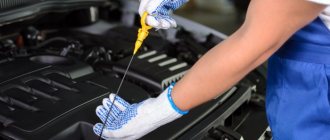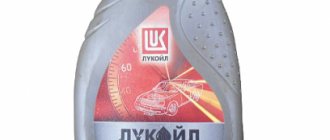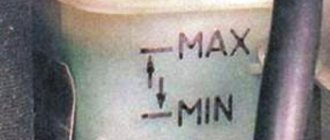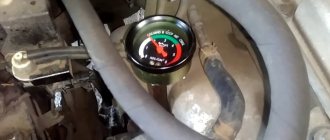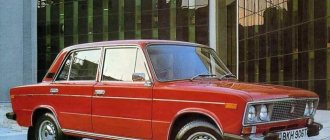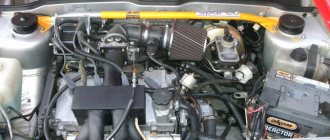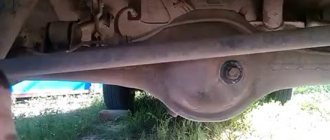Oil change period in the VAZ 2105 engine
Owners of already quite old VAZ-2105 cars are recommended to change the engine oil every 10 thousand km. In addition, you should also take into account the condition of the engine and the quality of the lubricant, which may become unusable much earlier than the specified period. For example, replacement every 6-7 thousand km may be required if the car is driven daily in harsh road and climatic conditions, and also spends most of its time in city traffic jams. Under such conditions, the load on the internal combustion engine increases significantly and the oil life decreases.
Instructions
- We warm up the engine to 45-50 degrees. Warm oil has better fluidity and will drain better from the engine during a complete replacement. Our task is to remove as much as possible the old dirty and used fluid that no longer has useful properties from the engine and fill it with new one. If a lot of old dirty oil remains in the crankcase, it will be swept away with the new one and will worsen its beneficial properties. Warm up the engine for 5-7 minutes before starting, this will be sufficient.
- For easy access to the drain plug (and in some models the oil filter is also attached from the bottom) and the bottom of the car as a whole, you need to jack it up or drive into an inspection hole (the best option). Also, some models may have engine crankcase “protection” installed.
- We open air access to the crankcase by unscrewing the filler cap and dipstick.
- Place a large container (equal to the amount of oil being poured).
- Unscrew the drain plug using a hexagon. Don't forget to wear protective gloves, the oil will most likely wake you up warm, but you need to be careful.
- We wait about 10-15 minutes until the waste flows into a basin or cut-off plastic canister.
- Optional but very effective! Flushing the engine with a special liquid is not included in the maintenance regulations and is not mandatory - but. By getting a little confused, you will be much better at flushing out the old, black oil from the engine. In this case, wash with the old oil filter for 5-10 minutes. You will be surprised at the black oil that comes out with this liquid. This liquid is very easy to use. A detailed description should appear on the flushing fluid label.
- Changing the sedum filter. In some models, it is not the filter itself or the filter element (usually yellow) that is changed. Impregnating the filter with new oil before installation is a mandatory procedure. Lack of oil in the new filter before starting the engine can cause oil starvation, which in turn can cause filter deformation. Overall this is not a good thing. Also remember to lubricate the rubber O-ring before installation.
- Fill in new oil. Having made sure that the drain plug is screwed in and a new oil filter is installed, we can begin to fill in new oil using the dipstick as a guide. The level should be between the minimum and maximum marks. Also, you need to remember that after the first start of the engine, some oil will leave and the level will drop.
- In the future, when the engine is running, the oil level will probably change; be careful during the first few days of operation. Recheck the oil level using the dipstick after the first start.
Changing the oil and oil filter VAZ “classic”
So, let's look at the oil change procedure using the VAZ 2106 as an example. First of all, the volume of oil in the VAZ 2106 engine for replacement is 3.75 liters. You also need to purchase a new oil filter that will be completely suitable for this type of engine.
- First of all, before changing the lubricant, the engine must be warmed up to operating temperatures. This will maximize the fluidity of the oil, which liquefies with heat. End of form
- Then the car needs to be lifted on a lift and driven onto an overpass or inspection hole. The main task is to gain free access to the drain hole, which is made in the oil pan.
- Next (in the case of an inspection hole or overpass), the car is fixed using the handbrake and engaging first gear. You can also additionally install wheel chocks, etc.
- If there is an installed engine crankcase protection, it is recommended to remove such protection, even taking into account the fact that a special hole may be made in the protection itself for draining the oil. This will make the procedure easier if you lack practical skills in changing the oil.
Now let's move on to the necessary tools. For example, on the popular VAZ “six” you will need:
- Allen key for 12 or cue ball with a wrench;
- Container for draining waste from the engine (volume 5 l.)
- Puller key for removing the oil filter;
- Funnel for pouring fresh oil;
- Rags, protective gloves, brush with metal bristles;
If the car has a crankcase protection, other keys may be required for dismantling (depending on the mounting features of the protection itself). After the engine has warmed up, the engine should be turned off. Then the protection is removed (if any). It is better to carry out all work wearing protective gloves.
Now you can lift the hood and unscrew the oil filler cap. If you plan to flush the engine and use a composition known as “five-minute solution,” then this product is poured directly into the exhaust, and the neck cap is screwed back on.
Next is a quick flush of the engine. When finished, you need to unscrew the neck cap again, go down under the car, placing a container under the place where the drain plug is installed in the pan.
Now the drain plug is cleaned with a brush with metal bristles, after which the drain plug is carefully unscrewed with a hex key. At the same time, if necessary, place a pre-prepared container to drain the oil.
Gradually and as the lubricant flows out, the plug is completely unscrewed. Next, the oil will flow out of the drain hole for about 15 minutes. This time is enough to wipe the drain plug with a clean rag.
When the oil stops dripping, the drain plug is screwed back in. If it is necessary to flush the engine before changing the oil using full-volume flushing fluids, then flushing oil is poured in, the oil filler cap is screwed back on and the internal combustion engine is flushed according to the instructions indicated on the package.
Having completed flushing the engine oil system, the procedure for changing the oil itself can be continued. The flushing is drained from the engine in the manner described above, the drain plug is screwed in.
How to replace a VAZ oil filter
Now, that is, immediately before adding fresh oil, you can proceed to replacing the oil filter. By the way, in some cases, especially if you need to wash the engine with full-volume flushing oil, it is recommended to replace the filter twice.
This means you must first remove the old one before washing, install a clean one (the cheapest one will do), then perform the washing itself. After washing, you will need to remove the recently installed cheap filter again and install a high-quality new one.
- Let's get back to the withdrawal. The oil filter can be removed quickly and easily using a special wrench puller. However, not everyone has such a key. For this reason, you need to familiarize yourself with how to unscrew the oil filter with a screwdriver or using other methods.
- Now you need to pour a little clean engine oil into the new filter, filling it halfway. This will allow the lubricant to saturate the filter elements in the housing. The rubber o-ring on the oil filter is also lubricated with oil.
Before installation, wipe the area where the filter is installed with a clean cloth, and then tighten the new filter by hand. Next, insert a funnel into the oil filler neck and pour in fresh oil.
Oil volume in the VAZ 2105 engine
| Engine | hp | Year of release (beginning-end) | Engine oil volume, l | |||
| 1.2 | B | VAZ-2101 | 64 | 1981 | 1999 | 3,75 |
| 1.3 | B | VAZ-2105 | 64 | 1980 | 1993 | 3.75 |
| 1.45 | B | VAZ-2103 | 77 | 1976 | 1988 | 3.75 |
| 1.6 | B | VAZ-21067 | 80 | 2010 | 2010 | 3.75 |
Replacement frequency, what oil to fill
According to the manufacturer's regulations, service changes of engine oil on the VAZ 2105 are carried out after 8,000-10,000 kilometers or at intervals of 1 year. But some car owners consider this interval to be a little too high, recommending that it be shortened taking into account operating conditions.
It is recommended to use semi-synthetic with a viscosity of 10W-40 as a lubricant. The following motor oils are most popular among model owners:
- Lada Professional 10W-40
- Lukoil Genesis Advanced 10W-40
- Shell Helix HX7 10W-40
- Total Quartz 7000 10W-40
When using this car in winter, you should select oil taking into account the climate zone, as well as the recommendations of AvtoVAZ. Viscosity 5W-40 will allow you to operate the car down to -30°C, and 0W-40 up to -35°C.
How much oil is in the engine lubrication system, volume table
| Model | Engine capacity | Motor marking | How many liters of oil are in the system | Original oil / factory filled |
| VAZ 2105 | gasoline 1.6 | VAZ-21067 | 3.75 | Lada Professional 10W-40 |
| VAZ-2106 | ||||
| gasoline 1.5 | VAZ-2103 | |||
| gasoline 1.3 | VAZ-21011 | |||
| VAZ-2105 | ||||
| VAZ-4132 | ||||
| gasoline 1.2 | VAZ-2101 | |||
| diesel 1.5 | VAZ-341 | TNK Magnum Super 10W-40 |
How much oil to pour into the VAZ 2105 engine
First generation 2105, 1979-2010
The 5 was built using the same frame and bodywork, despite the more angular '80s-style exterior panels. Instead of chrome-plated decorative parts, matte black plastic or painted metal appeared. In general, the external changes turned out to be cosmetic, but inside it was a completely different car - with a more comfortable front panel and improved driver ergonomics.
New seats - with better lateral support. The latest cars produced were almost no different from the original 2105 samples. So, in 2004, expensive aluminum bumpers were replaced by plastic ones, and in 2010 it was decided to abandon metal door handles in favor of plastic ones. In the mid-2000s, the car began to be equipped with engines with a new distributed fuel injection system with an ECU and a new power system with an electric fuel pump. By that time, the car received seats from 2107 with a non-removable headrest.
Gasoline engines 1979-2010
- 1.2 59 l. With. (2101), oil volume - 3.75 liters, tolerance and viscosity: tolerance and viscosity: API-SG, SH, SJ, SL; SAE 5W-30, 10W-30, 10W-40, 0W-40, 0W-30
- 1.3 64 l. With. (2105), oil volume - 3.75 liters, tolerance and viscosity: tolerance and viscosity: API-SG, SH, SJ, SL; SAE 5W-30, 10W-30, 10W-40, 0W-40, 0W-30
- 1.3 69 l. With. (21011), oil volume - 3.75 liters, tolerance and viscosity: tolerance and viscosity: API-SG, SH, SJ, SL; SAE 5W-30, 10W-30, 10W-40, 0W-40, 0W-30
- 1.5 71 l. With. (2103), oil volume - 3.75 liters, tolerance and viscosity: tolerance and viscosity: API-SG, SH, SJ, SL; SAE 5W-30, 10W-30, 10W-40, 0W-40, 0W-30
- 1.6 75 l. With. (2106), oil volume - 3.75 liters, tolerance and viscosity: tolerance and viscosity: API-SG, SH, SJ, SL; SAE 5W-30, 10W-30, 10W-40, 0W-40, 0W-30
- 1.6 82 l. With. (2104), oil volume - 3.75 liters, tolerance and viscosity: tolerance and viscosity: API-SG, SH, SJ, SL; SAE 5W-30, 10W-30, 10W-40, 0W-40, 0W-30
Diesel engines 1996-2011
1.5 50 l. With. (BTM-341), oil volume - 3.75 liters, tolerance and viscosity: tolerance and viscosity: API-SG, SH, SJ, SL; SAE 5W-30, 10W-30, 10W-40, 0W-40, 0W-30
Leaks and problems
The higher the mileage of the VAZ 2105, the more problems appear, as in principle with any car. Most often this is due to natural wear and tear of the engine, causing oil to burn. Although the manufacturer allows for a small consumption.
There can be many reasons why an engine eats oil. And in each case they can be individual. But, over the years of the model’s existence, we can talk about the most common places where leaks occur.
If the breather is spewing or throwing oil, or if there is oil in the exhaust manifold, this may indicate a serious problem with the oil rings. In this case, you can try decoking with dimexide. But it is better to use special auto chemicals designed for these purposes.
A leak from under the valve cover may be due to a worn gasket. Sometimes simply replacing the gasket does not solve the problem. Since the cover itself may have significant curvature. Therefore, in some cases it will have to be replaced.
A white emulsion in the engine or on the oil filler cap may indicate condensation. This is a common occurrence when temperatures change from minus to plus, mainly in autumn or spring.
But if the emulsion is also observed on the dipstick, then this is already a sign of more serious problems. Most often we can talk about a broken cylinder block gasket. And in rare cases, a cracked cylinder head may be to blame.
Also, with this problem, you can find oil in the expansion tank. Sometimes, simply replacing the gasket is not enough. It may be necessary to grind the head itself, and this is completely different money for repairs.
All this is general information, which may manifest itself differently on each specific vehicle, since everyone’s operating modes are different. The same applies to places of leaks or oil leaks. Therefore, it is impossible to identify the cause from a distance.
Classification of motor oils
The manufacturer's recommendations do not regulate the type of oil applicable to the "Seven" engine. Mineral, synthetic and semi-synthetic oil can be poured into the engine if it meets the quality requirements.
Motor oil canisters are marked (for example, “API SJ” or “API SG/CD”), which informs about the quality of the product. When choosing oil, this is what you should pay attention to.
The abbreviation API ( American
Petroleum Institute )
means “American Petroleum Institute.” This is an American non-governmental organization that provides regulation of issues related to the gas and oil industries. One of the areas of API's work is the development of standards and recommended practices for the oil and gas industry.
Motor oil is standardized according to the following indicators:
- toxicity;
- washing ability;
- corrosive activity;
- effectiveness of protecting parts from friction;
- the amount of deposits remaining on parts over the period of operation;
- temperature characteristics.
The letters “S” and “C” mean that the oil is intended for gasoline or diesel engines.
The letter after "S" or "C" indicates the quality of the engine oil's performance characteristics. The markings are in alphabetical order. The further the letter is from “A”, the better the characteristics of the oil.
Oil suitable for VAZ 2107 is minimum “API SG/CD”.
Note: the SAE methodology (type “5W40” qualifies oil only by viscosity indicators. This classification does not take into account performance characteristics and quality.
Oil selection table by season (winter, summer)
| Year | Viscosity SAE all season from +25 to -25 °C | winter from -35 to 0 °C | summer from 0 to +35 °C |
Gasoline API Diesel API Type Recommended manufacturers
198015W-20 10W-30
| 5W-20 10W-20 10W-30 | 20W-30 20W-20 25W-30 25W-20 |
SGCD-IImineralkaRosneft, G-Energy, Mannol, Lotos198115W-30 15W-20 10W-30
| 5W-30 5W-20 10W-20 | 20W-20 20W-30 25W-20 |
SGCD-IImineral Kixx, G-Energy, Rosneft, Mannol, Lotos198215W-20 15W-30 15W-40 10W-40
| 5W-30 5W-20 10W-40 | 20W-20 20W-30 25W-20 |
SGCD-IImineralkaLukoil, Valvoline, Kixx, G-Energy, Rosneft198315W-30 15W-20 15W-40 10W-40
| 5W-30 5W-20 10W-40 | 20W-20 20W-30 20W-40 25W-20 |
SGCD-II mineral Mobil, Kixx, G-Energy, Rosneft, Mannol, Lotos198415W-20 15W-40
| 5W-20 5W-30 10W-40 | 20W-30 20W-20 20W-40 25W-20 |
SGCD-II mineral water ZIC, Lukoil, Valvoline, Kixx198515W-20 15W-30 15W-40 10W-30
| 5W-20 5W-30 10W-30 10W-40 | 20W-30 20W-20 20W-40 25W-30 25W-20 |
SGCD-II mineral water ZIC, Lukoil, Valvoline, Kixx, G-Energy198615W-20 15W-30 15W-40 10W-30
| 5W-20 5W-30 10W-30 10W-40 | 20W-30 20W-20 20W-40 25W-30 |
SGCD-IImineral, hydrocrackingLukoil, Valvoline, Kixx, G-Energy, Rosneft, CONSOL198715W-20 10W-30 10W-20
| 5W-20 5W-30 10W-30 | 20W-30 20W-20 25W-30 |
SGCD-IImineral, hydrocrackingXado, ZIC, Lukoil, Valvoline, G-Energy, Rosneft198815W-20 10W-30 10W-20
| 5W-20 5W-30 10W-30 | 20W-30 20W-20 25W-30 |
SGCD-IImineral, hydrocrackingLukoil, Valvoline, Kixx, G-Energy, Rosneft198915W-30 15W-20 10W-30 10W-20
| 5W-20 5W-30 10W-30 | 20W-30 20W-20 25W-20 25W-30 |
SGCD-IImineral, hydrocrackingG-Energy, Rosneft, Mannol, Lotos, Total, AGA199015W-30 15W-20
| 5W-20 5W-30 10W-30 | 20W-30 25W-20 25W-30 |
SGCD-IImineral, hydrocrackingKixx, G-Energy, Rosneft, Mannol, Lotos, Total, AGA199110W-30 10W-40 15W-30 15W-40
| 5W-30 10W-40 10W-30 | 20W-30 25W-20 25W-30 |
SGCD-IImineral, hydrocrackingMobil, Kixx, G-Energy, Rosneft, Mannol, Lotos, Total, AGA199210W-30 10W-40 15W-30 15W-40
| 5W-30 10W-40 10W-30 | 20W-30 25W-20 25W-30 |
SGCD-IImineral, hydrocrackingGt-Oil, Kixx, G-Energy, Rosneft, Mannol, Lotos, 199310W-30 10W-40 15W-30 15W-40
| 5W-30 5W-40 10W-40 | 20W-30 20W-40 25W-20 25W-30 |
SGCD-IImineral, hydrocrackingGt-Oil, Kixx, G-Energy, Rosneft, Mannol, Lotos199410W-30 10W-40 15W-30 15W-40
| 5W-30 5W-40 10W-40 | 20W-30 20W-40 25W-30 |
SGCEmineral, hydrocrackingMobil, Kixx, G-Energy, Rosneft, Mannol199510W-30 15W-30 15W-40 5W-30
| 5W-30 10W-30 | 20W-30 25W-30 |
SGCEsemi-synthetics, mineral water, hydrocrackingGt-Oil, Kixx, G-Energy, Rosneft, CONSOL199610W-30 10W-40 15W-30
| 5W-30 10W-30 | 20W-30 25W-30 25W-20 |
SGCEsemi-synthetics, mineral water, hydrocrackingMobil, Valvoline, Kixx, G-Energy, Rosneft, Mannol199710W-40 15W-30 15W-40
| 5W-20 5W-30 10W-30 10W-40 | 20W-30 25W-30 |
SGCEsemi-synthetics, mineral water, hydrocrackingKixx, G-Energy, Rosneft, CONSOL199810W-30 10W-40 15W-30 5W-40SHCF-4semi-synthetics, mineral waterMobil, Valvoline, Kixx, G-Energy, CONSOL199910W-30 10W-40 15W-30
| 5W-30 5W-40 | 20W-40 20W-30 25W-30 |
SHCFsemi-synthetics, mineral waterValvoline, Kixx, G-Energy, Rosneft, CONSOL200010W-30 10W-40 15W-40 15W-30
| 5W-30 5W-40 | 20W-40 20W-30 25W-30 |
SJCF semi-synthetics, mineral waterMobil, ZIC, Lukoil, Valvoline, Rosneft, Mannol200110W-30 15W-40 15W-30
| 5W-20 5W-30 5W-40 | 20W-40 20W-30 25W-30 25W-40 |
SJCG semi-synthetic, mineral water Xado, ZIC, Lukoil, Valvoline, Kixx200210W-30 10W-40 15W-40 15W-30
| 5W-20 5W-30 5W-40 | 20W-40 20W-30 25W-30 25W-40 |
SJCG semi-synthetics, mineral water ZIC, Lukoil, Valvoline, Select, Kixx, G-Energy, Rosneft, Mannol, Lotos200310W-30 10W-40 15W-40 15W-30
| 5W-20 5W-30 5W-40 | 20W-40 20W-30 25W-30 25W-40 |
SJCG-4semi-synthetic, mineral waterMobil, Rosneft, Select, Mannol, Lotos200410W-30 10W-40 15W-40 15W-30
| 5W-30 5W-40 0W-30 | 20W-40 20W-30 25W-30 25W-40 |
SJCHsemi-synthetic, mineral waterMobil, Select, Mannol, Lotos200510W-40 5W-40
| 5W-40 | 20W-40 25W-30 25W-40 |
SHCH-4 semi-synthetic, mineral water Mobil, ZIC, Lukoil, Valvoline, Rosneft, Select200615W-40 10W-40 5W-40
| 0W-30 5W-40 5W-30 | 20W-30 20W-40 25W-30 |
SJCH-4semi-synthetic, mineral waterMobil, Lukoil, Valvoline, Rosneft, CONSOL200710W-40 5W-40
| 0W-30 5W-40 | 20W-40 25W-30 25W-40 |
SLCH-4semisyntheticsMobil, ZIC, Lukoil, Valvoline, Rosneft, CONSOL200810W-40 5W-40SLCIsemisyntheticsMobil, Xado, ZIC, Lukoil, Valvoline, Kixx, G-Energy, Rosneft, Mannol200910W-40 15W-40 5W-40
| 0W-40 5W-40 | 20W-40 25W-40 25W-40 |
SLCIsemisyntheticsMobil, Xado,Valvoline, Kixx, G-Energy, Rosneft, Mannol201010W-40 15W-40 5W-40SLCI-4semisyntheticsMobil, Xado, ZIC, Lukoil, Valvoline, Kixx, G-Energy, Rosneft, Mannol
What oil to use for the VAZ 2105 engine
Original
VAZ-2105 owners use mineral, semi-synthetic or synthetic motor oil with different viscosities. Semi-synthetics are considered the most popular for this model. Viscosity is selected depending on temperature conditions. For example, for year-round operation, a 10W-40, 10W-30 or 5W-40 all-season oil is recommended. In the winter season, it is better to fill in 0W-30, 0W-40 or 5W-30, and in the summer you can opt for 20W-40 or 25W-50.
Unoriginal
Owners of VAZ-2105 cars prefer inexpensive motor oils from domestic brands Lukoil, Rosneft, G-Energy and Gazpromneft. When choosing a suitable product, it is necessary to take into account the API approval, which is selected depending on the year of manufacture of the car, as well as the type of internal combustion engine. For example, for a gasoline VAZ-2105 produced in 1980. All-season mineral oil with parameters 15W-20 and API-SG is suitable. For cars of the 2010 model year, semi-synthetic API-SL is recommended. Below are the best options for analogue motor oils for the VAZ-2105.
- ZIC X5 10W-40
- Lukoil Lux 10W-40
- Mobil Super 3000 5W-40
- G-Energy 10W-40
- Eneos 10W-40.
Criteria for selecting VAZ 2105 oil
All oils are selected based on compliance with SAE, ACEA, API.
- In terms of composition, it is optimal to use semi-synthetics for used VAZs.
- ACEA A3/B3-B4.
- API SF for models up to 2000, for more recent API SG, SJ. VAZ 2105 was produced until 2010 inclusive.
AvtoVAZ offers the following table to select the appropriate viscosity:
| Minimum engine cold start temperature, °C | Viscosity grade according to SAE J 300 | Maximum ambient temperature, °C |
| -35 | 0W-30 | 25 |
| -35 | 0W-40 | 30 |
| -30 | 5W-30 | 25 |
| -30 | 5W-40 | 35 |
| -25 | 10W-30 | 25 |
| -25 | 10W-40 | 35 |
| -20 | 15W-40 | 45 |
| -15 | 20W-40 | 45 |
But most often, drivers pour 10w-40 into models with significant mileage, into more recent 5w-30.
Information on viscosity for a specific engine can be found in the motor oil interchangeability catalog: https://www.northsealubricants.com/en/oil-advisor
The catalog can be trusted, the data is taken from car manufacturers. In this case, you can choose not only oil for the engine, but also for the gearbox, power steering, brake system, and cooling system. That is, all liquids.
Original LADA oils
#1
LADA PROFESSIONAL 5W-40
Best price Yandex Market
#2
Lada Ultra 5W-40 API SN/CF
Best price Yandex Market
The supplier of original oils for AvtoVAZ is the Rosneft company, so branded oils can be replaced by any product from this manufacturer that meets the specifications.
Oil volume in the VAZ-2107 engine
According to the instructions, the engine oil level in a VAZ-2107 car should be 3.75 liters. In reality, it is not always possible to measure this level yourself. To determine the oil level in cars of this brand, it is recommended to use a metal dipstick; when pouring oil, focus on the min and max marks.
A four-liter canister goes entirely to the VAZ engine, since many people simply fill in the remaining oil in excess of the norm (in reserve). Oil consumption does not end there. A manual transmission, and with it the rear axle gearbox, require an average of 1.3 liters of lubricant, and an automatic transmission requires 1.6 liters.
Changing the oil and oil filter VAZ “classic”
So, let's look at the oil change procedure using the VAZ 2106 as an example. First of all, the volume of oil in the VAZ 2106 engine for replacement is 3.75 liters. You also need to purchase a new oil filter that will be completely suitable for this type of engine.
- First of all, before changing the lubricant, the engine must be warmed up to operating temperatures. This will maximize the fluidity of the oil, which liquefies with heat. End of form
- Then the car needs to be lifted on a lift and driven onto an overpass or inspection hole. The main task is to gain free access to the drain hole, which is made in the oil pan.
- Next (in the case of an inspection hole or overpass), the car is fixed using the handbrake and engaging first gear. You can also additionally install wheel chocks, etc.
- If there is an installed engine crankcase protection, it is recommended to remove such protection, even taking into account the fact that a special hole may be made in the protection itself for draining the oil. This will make the procedure easier if you lack practical skills in changing the oil.
Design nuances
To obtain the above engine characteristics, the manufacturer carried out experiments:
- piston stroke reduced to 66 mm;
- the cylinder diameter, on the contrary, is increased to 79 mm.
The result was a revving, powerful engine with an aluminum valve cover that absorbed the sounds of the drive. Another feature of the internal combustion engine is the fastening of the timing belt pulley - users do not need to unscrew the bolt on the crankshaft, unlike previous VAZ engine models.
In the operating instructions, the manufacturer recommends which oil to pour into the engine - 5W30 - 15W40.

